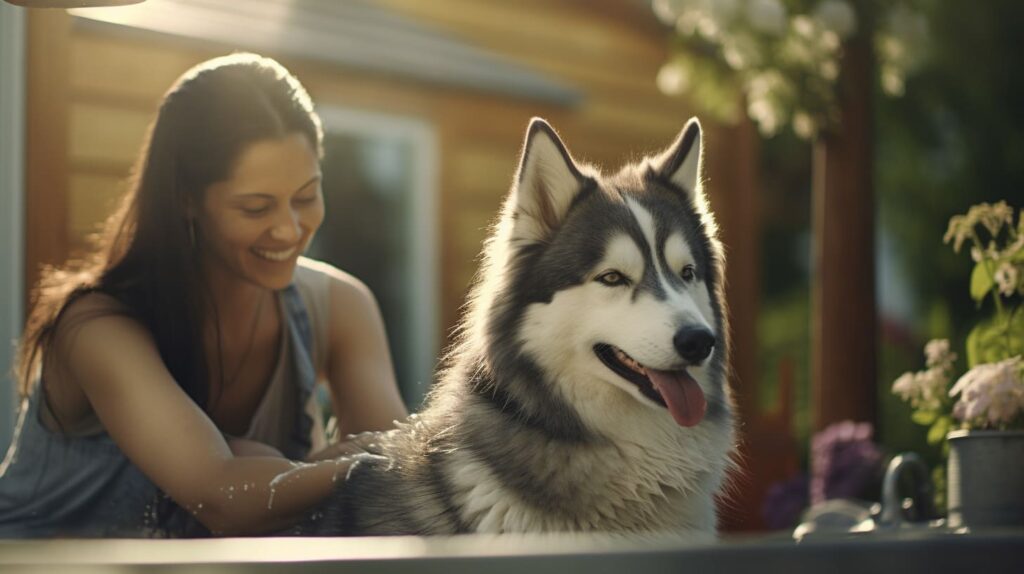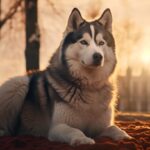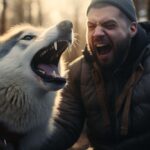Huskies are renowned for their stunning looks and majestic coats, which contribute to their popularity among dog enthusiasts. However, behind the beauty lies a grooming regime that requires a diligent approach to keep their coat healthy and beautiful. Regular grooming is not merely a cosmetic venture; it’s a health necessity for Huskies. It helps in keeping their skin healthy, shedding under control, and provides an opportunity to check for signs of skin problems, infections, or other health issues.
In this article, we delve into a detailed guide on how to groom a Husky, ensuring that their coat remains in tip-top shape and they stay comfortable and happy. The guide covers everything from understanding your Husky’s coat and gathering the necessary grooming supplies to the step-by-step grooming process. Whether you’re a new Husky parent or looking to refine your grooming skills, this guide aims to provide the essential information needed to make the grooming process a breeze. So, grab your grooming tools, and let’s embark on the grooming journey that awaits you and your Husky.
Table of Contents
Understanding a Husky’s Coat
The Siberian Husky boasts a lush, thick coat that not only looks majestic but also serves crucial functions. The coat is designed to protect them from harsh weather conditions in cold climates. Understanding the intricacies of a Husky’s coat is the first step towards effective grooming.
Dual-layer Coat
Huskies have a dual-layer coat consisting of a dense undercoat and a longer topcoat. The undercoat provides insulation, keeping them warm during winter and cool during summer, while the topcoat helps repel water and protect against harsh weather elements.
Shedding Cycle
Huskies go through significant shedding cycles, especially during the spring and fall, when they “blow” their undercoats. Regular grooming helps manage the shedding, keeping your home fur-free and your Husky comfortable.
Common Coat Concerns
Due to their thick coats, Huskies are prone to certain skin and coat concerns. These include matting, which can cause skin irritation and harbor parasites. Additionally, inadequate grooming can lead to skin infections due to moisture and dirt trapped close to the skin.
Regular grooming is not only about keeping your Husky looking good; it’s about maintaining their skin and coat health, contributing to their overall well-being. A well-groomed Husky is a happy and comfortable Husky. Understanding the nature of your Husky’s coat and its needs will equip you with the necessary knowledge to tackle the grooming process effectively. Through consistent grooming, you’ll help preserve the natural beauty and health of your Husky’s coat, making them look as majestic as they deserve.
Gathering Your Grooming Supplies
Before you dive into the grooming process, assembling the right tools and products is crucial. Having the right supplies on hand will make the grooming experience more efficient and enjoyable for both you and your Husky.
Essential Grooming Tools
- Brushes and Combs: A good quality slicker brush and an undercoat rake are indispensable for managing your Husky’s thick coat. Additionally, a stainless steel comb can help in detangling and checking for mats.
- Nail Clippers: Choose a sturdy pair of nail clippers designed for dogs. Guillotine-style or scissor-style clippers are both good options, depending on what you find easier to use.
- Ear Cleaning Supplies: Purchase a vet-approved ear cleaner and cotton balls or pads to keep your Husky’s ears clean and infection-free.
- Toothbrush and Toothpaste: A dog-specific toothbrush and toothpaste are essential for maintaining your Husky’s dental health.
- Shampoo and Conditioner: Select a gentle, dog-specific shampoo and conditioner that will clean without stripping the natural oils from your Husky’s coat.
Quality Over Quantity
Investing in high-quality grooming tools will pay off in the long run. Quality tools will not only last longer but will also provide a better grooming experience. They are typically designed to be more effective and comfortable to use, making the grooming process quicker and less stressful for your Husky.
Organizing Your Grooming Supplies
Having a designated grooming area and keeping your grooming supplies organized will help streamline the grooming process. Consider storing your grooming tools in a portable caddy or a designated drawer so they are easy to access whenever grooming time rolls around.
Preparing ahead with the right tools and products will set the stage for a successful grooming session. Ensuring you have everything you need before you begin will help create a calm, efficient grooming environment, which in turn will make the experience more pleasant for both you and your Husky.
Pre-Grooming Preparation
Before you venture into grooming your Husky, setting the right environment and getting your furry friend accustomed to the grooming tools and handling is vital. This preparatory stage lays the foundation for smooth grooming sessions now and in the future.
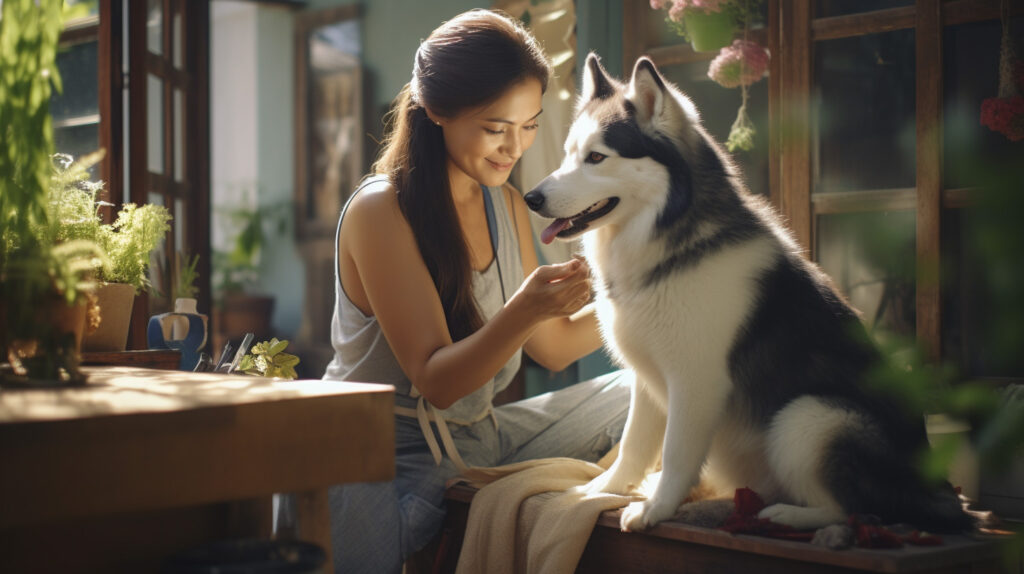
Creating a Comfortable Grooming Environment
Creating a relaxed atmosphere is essential for a stress-free grooming experience. Choose a quiet, well-lit area away from distractions. Make sure the space is comfortable for both you and your Husky. A non-slip mat can be helpful to keep your Husky steady during the grooming session.
Acclimating Your Husky to Grooming Tools
Before the actual grooming, let your Husky sniff and inspect the grooming tools. Gently run the brushes against their coat without actually brushing them, allowing them to get used to the sensation. This step is especially important for puppies or Huskies who have never been groomed before.
Handling Practice
Practice handling your Husky’s paws, ears, and mouth, as you’ll need to touch these areas during grooming. Reward them with praise and treats for allowing you to handle them. This will help build positive associations with grooming.
Rewarding Calm Behavior
Encourage and reward calm behavior throughout the pre-grooming stage. Use positive reinforcement techniques such as praise, petting, and treats to make the experience enjoyable for your Husky.
Establishing a Routine
Establishing a routine around grooming helps your Husky know what to expect. Having a set grooming schedule and sticking to it will help your Husky become more comfortable with the grooming process over time.
Taking It Slow
Take it slow, especially if it’s your Husky’s first time being groomed or if they’re nervous. Short, positive grooming sessions to start will help build a positive association with grooming.
The pre-grooming preparation is all about setting the right tone for grooming. A comfortable environment, positive experiences with grooming tools and handling, and a patient, gentle approach will make grooming a pleasant activity for both you and your Husky. Investing time in pre-grooming preparation sets the stage for countless smooth grooming sessions in the future.
Brushing Your Husky
Brushing is a cornerstone of Husky grooming, given their thick double coats. Regular brushing helps to remove loose fur, prevent mats, and keep the coat looking its best. Here’s a step-by-step guide on how to effectively brush your Husky.
Step 1: Choose the Right Brush
Start with a good quality slicker brush or an undercoat rake, which are ideal for penetrating a Husky’s thick coat. These brushes can reach down to the undercoat to remove loose fur and detangle any mats.
Step 2: Get Your Husky Comfortable
Before you start brushing, ensure your Husky is calm and comfortable. It may help to go for a walk or play a game to burn off excess energy before grooming.
Step 3: Start Brushing
Begin brushing at the head and work your way down the body. Brush in the direction of the hair growth, starting with the topcoat. Be gentle to avoid irritating the skin.
Step 4: Reach the Undercoat
After brushing the topcoat, use an undercoat rake to reach the dense undercoat. This will help remove any loose fur and prevent mats.
Step 5: Check for Mats and Tangles
As you brush, check for mats and tangles. If you find any, use a comb to gently work them out, or a mat splitter if necessary.
Step 6: Be Thorough But Gentle
Ensure you cover all areas, including the legs and belly. However, be extra gentle on sensitive areas and ensure you’re not pulling or tugging on the fur.
Step 7: Reward Your Husky
After the brushing session, reward your Husky with praise, petting, or a treat. This will help build positive associations with grooming.
Step 8: Regular Brushing Schedule
Establish a regular brushing schedule, at least once a week, or more often during shedding season. Consistent brushing will help keep shedding under control and the coat in good condition.
Brushing is more than just a grooming task; it’s a bonding activity that promotes a healthy coat and skin. It also allows checking for any skin issues, parasites, or abnormalities. By following these steps, you’ll ensure that your Husky remains comfortable throughout the brushing process and keep their coat looking majestic and healthy.
Bathing Your Husky
Bathing a Husky isn’t a frequent necessity due to their self-cleaning coat, but when the time comes, it’s important to do it right. Here’s a step-by-step guide on how to give your Husky a comfortable and effective bath.
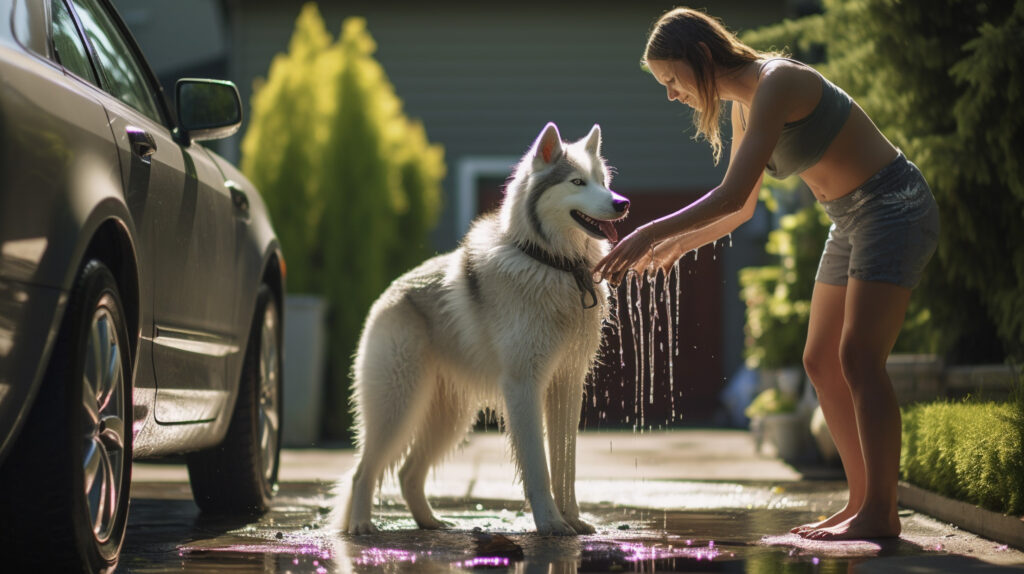
Step 1: Prepare the Bathing Area
Choose a suitable area for bathing, like a bathtub or a dog-friendly shower area. Make sure the area is clean and free of hazards. Place a non-slip mat to prevent your Husky from slipping.
Step 2: Gather Your Supplies
Have your dog-specific shampoo, conditioner, towels, and a detachable showerhead or a large cup for rinsing ready.
Step 3: Brush Your Husky
Before the bath, give your Husky a thorough brushing to remove any loose fur and detangle mats. This will make the bathing process much easier.
Step 4: Wet Your Husky’s Coat
Using lukewarm water, wet your Husky’s coat thoroughly. Avoid getting water in their ears, eyes, or nose.
Step 5: Apply Shampoo
Apply a gentle, dog-specific shampoo to your Husky’s coat. Work the shampoo in with your fingers, creating a lather. Be gentle and make sure to cover all areas.
Step 6: Rinse Thoroughly
Rinse the shampoo out completely, ensuring no residue is left behind. It’s crucial to rinse thoroughly as leftover shampoo can cause skin irritation.
Step 7: Apply Conditioner (Optional)
If you choose to use conditioner, apply it following the same procedure as the shampoo. Rinse thoroughly.
Step 8: Dry Your Husky
Use towels to remove excess water from your Husky’s coat. If your Husky is comfortable with it, use a dog-safe blow dryer on a cool setting to dry them off. Make sure to keep the blow dryer moving to prevent overheating any area.
Step 9: Final Brush
Once your Husky is dry, give them a final brush to remove any remaining loose fur and to keep their coat looking tidy.
Bathing should be a calm and positive experience for your Husky. Keeping a regular, but not too frequent, bathing schedule will help your Husky stay clean and comfortable. It’s all about finding the right balance and making the experience enjoyable for your beloved Husky.
Drying and Additional Brushing
After a refreshing bath, drying your Husky properly is crucial to prevent any skin issues and to keep their coat in good condition. Here’s how to go about it.

Step 1: Towel Dry
Begin by towel drying your Husky to remove the excess water from their coat. Use a soft, absorbent towel and gently pat and rub the coat to soak up as much water as possible.
Step 2: Air Dry
If the weather is warm, you can let your Husky air dry. Huskies are generally not fond of blow dryers, and air drying is a natural and comfortable method.
Step 3: Blow Dry (Optional)
If your Husky tolerates it, you can use a blow dryer on a low heat setting to speed up the drying process. Ensure to keep the dryer moving to avoid overheating one spot. It’s advisable to use a pet-specific blow dryer as they are quieter and have a lower heat setting to ensure your Husky’s comfort.
Step 4: Additional Brushing
Once your Husky is dry, it’s time for another brushing session. Brushing after a bath helps to remove any remaining loose fur, detangle any mats that may have formed during the bath, and gives the coat a nice finish.
Step 5: Reward Your Husky
After a successful drying and brushing session, reward your Husky with some treats and praise. This helps to reinforce positive grooming behavior.
Step 6: Inspect Your Husky
As you dry and brush your Husky, take the opportunity to inspect their skin and coat for any abnormalities such as cuts, scrapes, or signs of infection. Regular inspections can help catch potential issues early.
Step 7: Maintain a Routine
Maintaining a consistent grooming routine will help your Husky get accustomed to the process, making it easier over time. It also helps to keep their coat in a pristine condition.
Proper drying and additional brushing are key steps in the grooming process. They help to ensure that your Husky’s coat remains healthy, shiny, and free from mats. By following these steps, you’ll ensure that your Husky remains comfortable and looks their best after each grooming session.
Paw, Ear, and Dental Care
Beyond the coat, other parts of your Husky need regular attention to ensure overall health and comfort. Here’s a breakdown of how to care for your Husky’s paws, ears, and teeth.
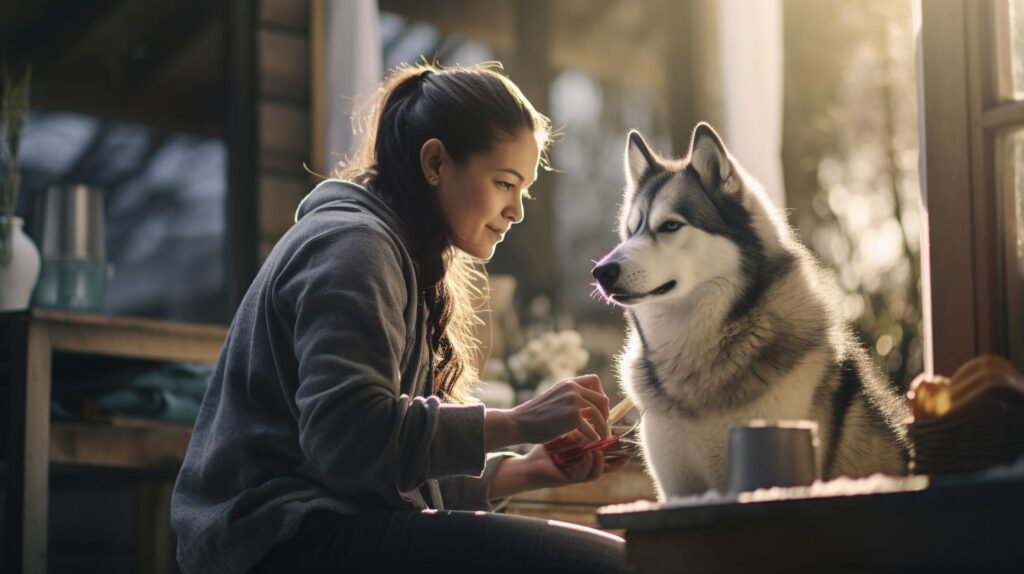
Paw Care
- Regular Inspection: Inspect your Husky’s paws regularly for any cuts, sores, or foreign objects lodged between the pads.
- Nail Trimming: Trim your Husky’s nails using a dog nail clipper or grinder. It’s essential to keep their nails at a comfortable length to prevent discomfort or injury.
- Pad Moisturizing: If your Husky’s pads are dry or cracked, use a dog-safe paw balm to moisturize them.
Ear Care
- Regular Checking: Check your Husky’s ears for any signs of infection, irritation, or wax build-up.
- Cleaning: Use a vet-approved ear cleaner and cotton balls to gently clean the outer ear canal. Avoid going too deep to prevent injury.
Dental Care
- Regular Brushing: Brush your Husky’s teeth using a dog toothbrush and toothpaste. Regular brushing helps prevent tartar build-up and promotes good oral health.
- Dental Treats and Toys: Provide dental treats and toys that help clean the teeth and gums as your Husky chews on them.
Professional Check-ups
Regular vet check-ups are crucial for keeping tabs on your Husky’s paw, ear, and dental health. Your vet can provide further advice on maintaining these areas and address any concerns you may have.
Rewarding Cooperation
Reward your Husky for cooperating during these grooming tasks with praise, petting, or treats. This positive reinforcement will make future grooming sessions easier.
Caring for your Husky’s paws, ears, and teeth is an integral part of the grooming routine. By paying attention to these areas, you ensure your Husky remains healthy and comfortable from head to toe. Regular care and check-ups will help catch any potential issues early, making for a happy, healthy Husky.
Tail End Tidbits
Congratulations on mastering the art of Husky grooming! By now, you have a solid grasp on the necessary steps to keep your Husky looking fabulous and feeling great. Grooming is more than just a beauty routine; it’s a health and wellness regimen that significantly impacts your Husky’s quality of life.
The time and effort invested in grooming your Husky will foster a stronger bond between you two. It’s a time of interaction, trust-building, and can be enjoyable for both you and your furry companion. Moreover, regular grooming helps in early detection of potential health issues, which can be a lifesaver.
Here are some fluffy final facts to ponder:
- Consistency is Key: Establishing a regular grooming routine helps your Husky get accustomed to the process, making it less stressful over time.
- Quality Over Quantity: Invest in quality grooming tools and products. They might cost more upfront, but they’re more effective and last longer.
- Patience and Positive Reinforcement: Grooming can be a new, unfamiliar experience for your Husky. Approach each grooming task with patience, gentle handling, and lots of positive reinforcement to create a positive grooming experience.
Remember, every Husky is unique, and what works for one may not work for another. It may take some time to figure out what grooming routine and products work best for your Husky. With patience, consistency, and the right tools, you’ll have a well-groomed Husky that is the envy of the neighborhood. Your Husky’s majestic coat, clean ears, sparkling teeth, and well-manicured paws are now a sight to behold and a testament to your Husky’s well-being and diligent care. Happy grooming!
